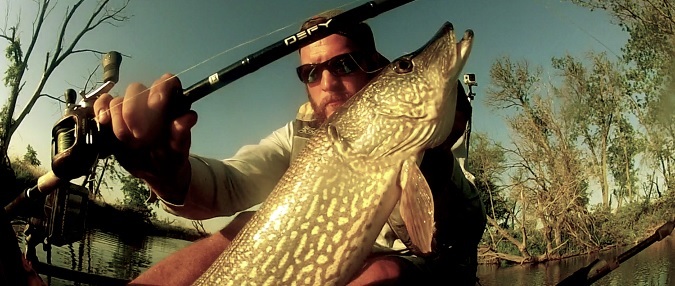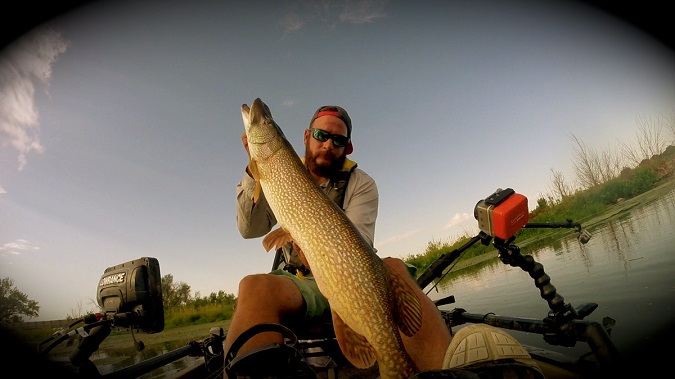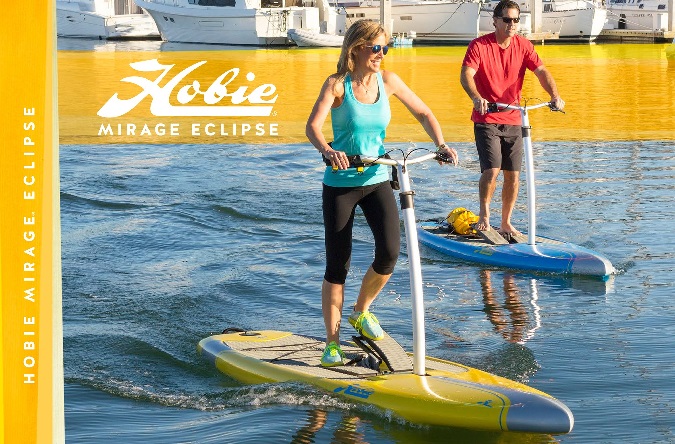My topwater frog sailed toward me in a spray of water and plant material. A few seconds later I’d whipped it back into the filling crater where the water had just parted. The pike was still there, a dark shadow looming under the bait. The frog twitched and the pike unloaded as if fired from Triton’s spear. I let him swim down with the bait and then tried to drive the hooks home.

The fish was pinned for a few slow motion heartbeats and then the rod relaxed and the water settled. The fish was gone but I would return for it later and settle the score. There is something different about chasing one of freshwater’s most intense apex predators. A deeper respect and a greater reward, perhaps the fish has earned this value itself. Whenever hooks, teeth and a general bad attitude are involved, kayak fishing reaches its pinnacle of excitement. To enjoy success catching trophy pike in the Hobie, preparation in the key.
Before you launch and start seeking out pike or muskie there are a few tools you must have in your kayak. A pair of long reach needle-nose pliers are essential for removing and possibly cutting hooks. A knotless, rubber landing net of appropriate size can make a big difference. You can use the net to safely unhook, photograph and release the fish. You can also learn a proper gill hold and how to safely handle pike. This is best learned by experience. Get a good grip on the fish. When a fish gets loose in the kayak there are increased chances for an accident. An extendable measuring board or tape on your kayak, even a floating measuring pole are great ways to get accurate size measurements.
Another essential is having the proper rod, reel and line combination. Northern Pike in the upper 30 inch range on up will give a fierce battle and test your gear. This year my favorite set-up has been my 8-foot swimbait rod. This heavy rod called the Defy Black from 13 Fishing has been great for driving big hooks home from the Vantage seat. I also use at least a 7:1:1 gear ratio on my bait caster reel. I use a Concept A3 reel loaded with 50-pound braid. I attach the braid to a 60- to 80-pound fluorocarbon leader. Even with the heavy leader it is important to check the line for abrasion after catching fish. A rod with plenty of backbone and a fairly fast reel that can handle braided line are must haves. You are doing the pike and yourself an injustice by chasing them under-equipped or fishing without a leader.

Once you have the proper equipment it is time to break down the local waters and find the pike. As with most big predators, location is the most important ingredient to success. Pike are seasonal fish and follow predictable patterns. Two of the main factors used to unlock seasonal patterns are water temperature and location of forage. Some of the largest pike will stay in water closest to optimum temperature for good metabolism, especially in the heat of summer.
Once an area reaches water temperatures above the mid-70 degree range I quit targeting pike and muskie due to excess stress put on the fish by warm water and being caught. It has been shown that targeting pike in warm water can often lead to delayed mortality. All the way from the northern reaches of their range to the southern reaches in the midwest, pike are attracted to oxygenated water near current. If you can find areas with optimum water temperatures, plenty of forage and some current you will likely find your pike.
While some pike will move to open water areas in search of schooled up baitfish, there are also pike that hide in vegetation most of the year. For the kayak angler, casting along weed lines can be a killer tactic. I like to use topwaters, swimbaits and where I can I’ll burn a bucktail spinner over the weeds as well. Pike are aggressive fish and often the noisier and brighter the bait, the more ferocious the response.
However, despite the pike’s love for aquatic vegetation, open water and river environment fish can be targeted in the kayak as well. My Hobie Mirage Pro Angler is great for trolling or scanning large open water areas. I use my Lowrance Elite-7 to watch my trolling speed and look at things on the Totalscan screen.
I also use an adjustable Hobie rod holder to secure the rod I’m trolling with in easy reach. For trolling situations I like to use oversized bass crank baits, sometimes changing the hooks for a sturdier option. I’ll start high in the water column as pike tend to feed up, and then work my way down depending on the fish’s reaction. In rivers and early in the year I love to throw big jerkbaits along current seams. Many times it is a matter of simply using a bait that gets into the strike zone.
Once you’ve felt the slamming hit of a big northern and had one tow you around a bit, the addiction becomes real. In the kayak it’s a blast of wild action, especially when a gator pike appears next to your kayak and crushes your lure. It’s enough to get the adrenaline pumping and leave you endeared to a toothy smile.
By , Hobie Team
Check back weekly for new videos and stories by the Hobie Fishing Top Guns.

